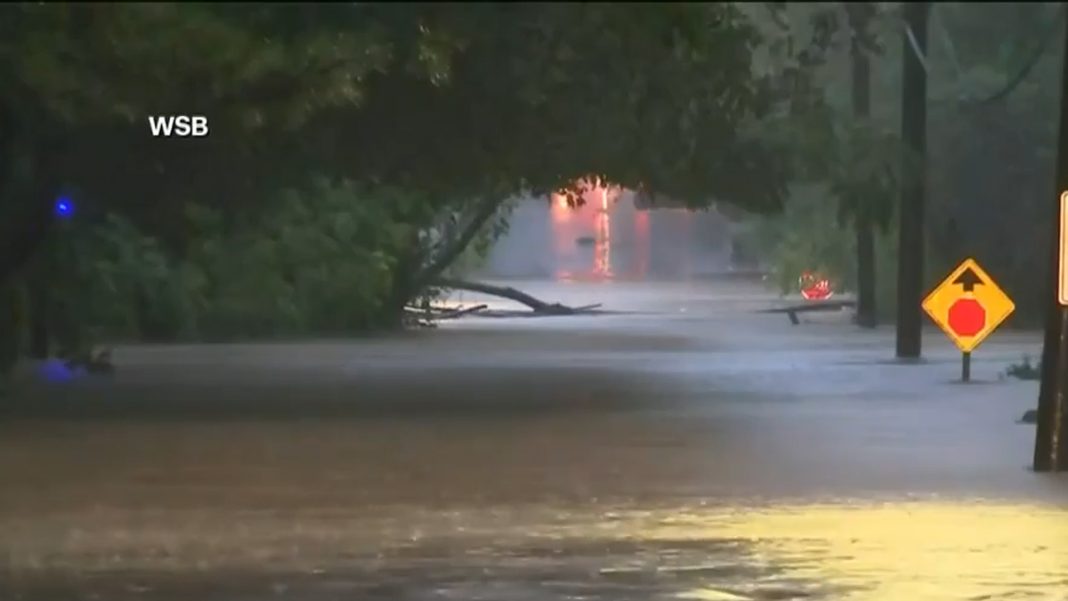As Hurricane Helene barreled ashore in Florida, its ferocity and impact were felt far beyond the coastline. With maximum sustained winds reaching 140 mph, this powerful Category 4 hurricane made landfall late Thursday in the rural Big Bend area, a region characterized by its serene fishing villages and vacation hideaways. However, the aftermath of Helene painted a starkly different picture, as emergency crews scrambled to rescue residents trapped in flooded homes, highlighting the storm’s devastating reach.
In the wake of Helene, the toll on human life was tragic. Reports indicated at least 11 fatalities in Georgia, alongside six more in Florida and the Carolinas. The state’s governor, Brian Kemp, confirmed that dozens remained trapped in homes that suffered significant damage. The storm’s catastrophic surge and flooding extended hundreds of miles inland, with areas as distant as North Carolina experiencing severe inundation, including a lake that overtopped a dam—a location made famous by the film “Dirty Dancing.”
As the storm wreaked havoc, Rhonda Bell from Valdosta, Georgia, expressed relief, stating, “Thank God we’re both alive to tell about it,” after a massive oak tree crashed through her roof. The emotional toll on communities was palpable. Stephen Tucker lamented the destruction to his church in Perry, Florida, which had just undergone a roof replacement after the previous year’s Hurricane Idalia. “It’s really heartbreaking,” he said, capturing the sentiment of many who had invested time and resources into rebuilding only to find themselves in the path of another disaster.
Governor Ron DeSantis provided a grim assessment, noting that the damage from Helene appeared to surpass the combined destruction of Idalia and another storm, Debby, from the previous August. “It’s demoralizing,” he stated, echoing the feelings of countless residents who felt the weight of repeated natural disasters.
In response to the catastrophe, President Joe Biden extended thoughts and prayers to the survivors while the Federal Emergency Management Agency (FEMA) mobilized over 1,500 workers to assist in recovery efforts. By late Friday morning, these teams had already conducted around 400 rescues, demonstrating the urgency of the situation. Local authorities took swift action, deploying boats to reach stranded individuals amid rising floodwaters, which posed additional hazards such as live electrical wires and sewage contamination. “If you are trapped and need help please call for rescuers – DO NOT TRY TO TREAD FLOODWATERS YOURSELF,” emphasized the Citrus County sheriff’s office, a warning that underscores the dangers inherent in flood conditions.
The storm’s impact was not limited to physical damage; it also led to widespread power outages, leaving more than 4 million homes and businesses in Florida, Georgia, and South Carolina without electricity. This disruption further complicated recovery efforts and added to the stress faced by those impacted.
As Hurricane Helene moved inland, it weakened to a tropical storm, but not before leaving its mark. By midday Friday, it was reported to be approximately 105 miles northeast of Atlanta, continuing its trajectory northward. Forecasters warned that the remnants of Helene could trigger heavy rainfall and flash flooding as it moved into Tennessee and Kentucky, raising concerns about mudslides in the Appalachian Mountains.
The hurricane season, which began on June 1, has been marked by unusually warm ocean temperatures, leading the National Oceanic and Atmospheric Administration to predict an above-average number of storms this year. Helene is the eighth named storm of the season, serving as a stark reminder of the increasing intensity and frequency of such weather events.
In the days following the hurricane’s wrath, communities will need not only to recover physically but also to grapple with the emotional and psychological impacts of such disasters. As cities and towns begin the long process of rebuilding, the resilience of the human spirit will be tested once again. With each storm, the stakes grow higher, and the need for effective disaster preparedness and climate change adaptation strategies becomes ever more urgent.

